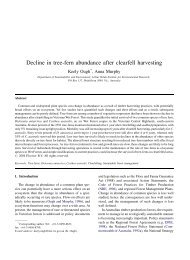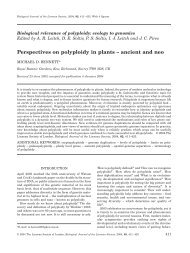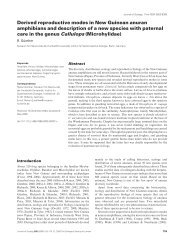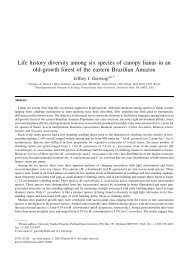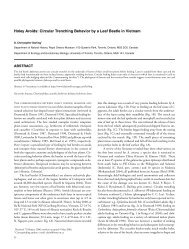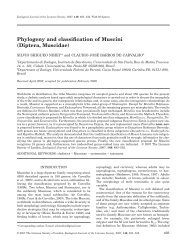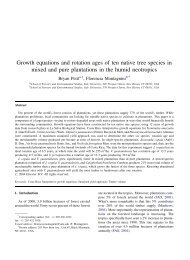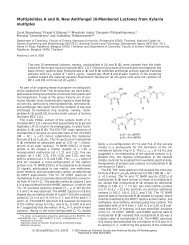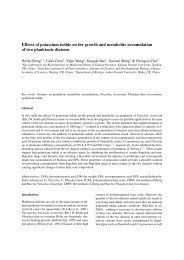Lichens and higher plants on stone: a review - AseanBiodiversity.info
Lichens and higher plants on stone: a review - AseanBiodiversity.info
Lichens and higher plants on stone: a review - AseanBiodiversity.info
You also want an ePaper? Increase the reach of your titles
YUMPU automatically turns print PDFs into web optimized ePapers that Google loves.
Plate 2. (a) Fourteenth century tower of San Giovanni, Elba isl<str<strong>on</strong>g>and</str<strong>on</strong>g>. The same kinds of lichens <str<strong>on</strong>g>and</str<strong>on</strong>g> <str<strong>on</strong>g>plants</str<strong>on</strong>g> grow <strong>on</strong> the surrounding granite <str<strong>on</strong>g>and</str<strong>on</strong>g> the st<strong>on</strong>es<br />
of the tower, also of local granite. (b) Archof an 18thcentury gate at Vignano, Siena. A cypress about 3 m highis growing between the bricks, to<br />
the detriment of the structure. (c) Crassulaceous plant (Sedum pachyphyllum) originating from a pot plant, growing <strong>on</strong> a mound of detritus c<strong>on</strong>sisting<br />
of moss <str<strong>on</strong>g>and</str<strong>on</strong>g> atmospheric dust at the base of the Altar of the Fatherl<str<strong>on</strong>g>and</str<strong>on</strong>g>, Rome (early twenties). (d) Walls of the town of San Quirico d’Orcia (Siena<br />
Province), hosting a plum tree. The roots of the plant have already dislodged many st<strong>on</strong>es. (e) Two examples of Dittrichia viscosa growing <strong>on</strong> the<br />
m<strong>on</strong>ument to Petrarch in Arezzo. The rhizome of the lower plant has already caused the marble to crack. (f) Ruins of the town of Maktar in Tunisia.<br />
Plants grow mostly in cracks <str<strong>on</strong>g>and</str<strong>on</strong>g> are periodically removed to keep the site accessible to tourists.<br />
3.2. Comm<strong>on</strong> <str<strong>on</strong>g>plants</str<strong>on</strong>g> col<strong>on</strong>izing m<strong>on</strong>uments<br />
Botanists have l<strong>on</strong>g been interested in <str<strong>on</strong>g>plants</str<strong>on</strong>g> that grow in<br />
the walls of European towns such as Cambridge (Rishbeth,<br />
1948), Durham (Woodell <str<strong>on</strong>g>and</str<strong>on</strong>g> Rossiter, 1959), Padua (Beguinot,<br />
1912, 1913, 1916a–c), Pavia (Traverso, 1898, 1899),<br />
Florence (Arrig<strong>on</strong>i <str<strong>on</strong>g>and</str<strong>on</strong>g> Rizzotto, 1994), Rome (Anzal<strong>on</strong>e,<br />
1951), Palermo (Cannarella, 1909, 1912) <str<strong>on</strong>g>and</str<strong>on</strong>g> other c<strong>on</strong>tinental<br />
towns (Kunick, 1982; Sukopp <str<strong>on</strong>g>and</str<strong>on</strong>g> Werner, 1983). In<br />
a recent study (Lisci <str<strong>on</strong>g>and</str<strong>on</strong>g> Pacini, 1993a, b), we examined<br />
the microsites in which <str<strong>on</strong>g>plants</str<strong>on</strong>g> become established, <str<strong>on</strong>g>and</str<strong>on</strong>g> their<br />
methods of col<strong>on</strong>izati<strong>on</strong> <str<strong>on</strong>g>and</str<strong>on</strong>g> reproducti<strong>on</strong>.



